The journey from Agra was pretty chaotic. The (overnight) train was late arriving, and there had been military interviews in the city that day so the station was packed with young Indian men. And it seemed that once again we were the focus of attention and attracted a small crowd wanting to talk, take selfies or just stare at us. Staring at strangers in India seems to be an acceptable pastime, but still isn’t something I find especially comfortable. On the train it’s even worse. Two families are occupying our ‘cabin’ with us and they have stacks of cases and boxes so there is nowhere for us to store our bags.
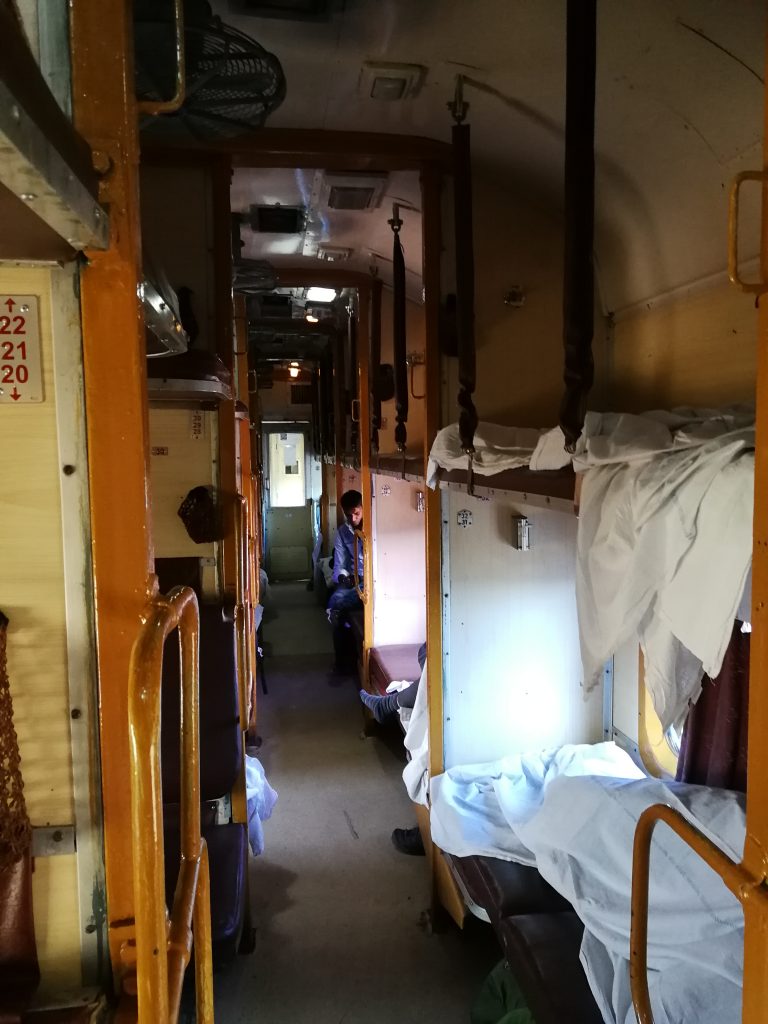
For the uninitiated, the AC3 Tier class (our class) has blocks of 8 bunks. Two tiers of 3 with two more bunks at the side parallel to the walkway. When all the bunks are up there is nowhere to sit and the only place for luggage is beneath the bottom bunk. Added to this, the advice is to lock your large bags to the seats and keep smaller bags on the bunk with you. A challenge when you don’t actually fit in the bunk in the first place! Anyway, after moving some things around, we eventually get bags stowed and take our places for a long night trying to sleep.
Sanjeev had said to us that Varanasi is a very spiritual, and very holy, place and that even when we got off the train we would feel that spirituality and it would touch us in some way.
Varanasi, (also known as Kashi (City of Life) and Benares) is one of the world’s oldest continually inhabited cities. Thought to date back to around 1200 BCE (although some people believe it is over 5000 years old), it is regarded as one of Hinduism’s seven holy cities making it a special place for Hindus. Pilgrims come to one of the 84 ghats lining the River Ganges here to wash away their sins in the sacred waters and to cremate their loved ones.
When we eventually did get off the train, nearly 5 hours late and in the heat of the day, it felt much like every other Indian city we’d been to. Dusty, hot, full of cows and dogs and with rubbish everywhere. The usual, except that the traffic seemed even worse and the tuktuk journey seemed more manic than ever. Our hotel was a short walk from the river, and after a swift lunch (more excellent veg curry and garlic naan) we set off with Sanjeev at the head to explore the old city of Varanasi stretching along the western bank of the Ganges. The ghats extend all along the bank, and you can walk all the way along them. Extending back from the riverbank are a labyrinth of disorienting alleys called galis that are too narrow for traffic (allegedly, although motor cycles and the ever present cows were constant hazards).
I hadn’t appreciated what effect the recent monsoons had on the local river front. The river runs very high during the wet season, higher than some of the ghats and up to the basement level of some of the buildings along the river. The consequence of this is that tons of mud and silt are deposited on the banks and even in some of the basements. Every year there is a big clean up operation after the monsoons where diesel pumps draw water from the river and the local men spray the mud and silt to wash it away and clean the steps and walkways along the river.
For us, it meant that on occasion we were paddling through a combination of mud, silt and Ganges river water. Now we had thought, from seeing documentaries on TV before we left, that the Ganges was highly polluted. However Sanjeev maintained that it is now in fact quite ‘clean’ having become something like 80% cleaner over the last 4 years. Whilst we didn’t want to go paddling or bathing in it like the devout Hindus, there didn’t seem to be any immediate impact of having the water on our feet!
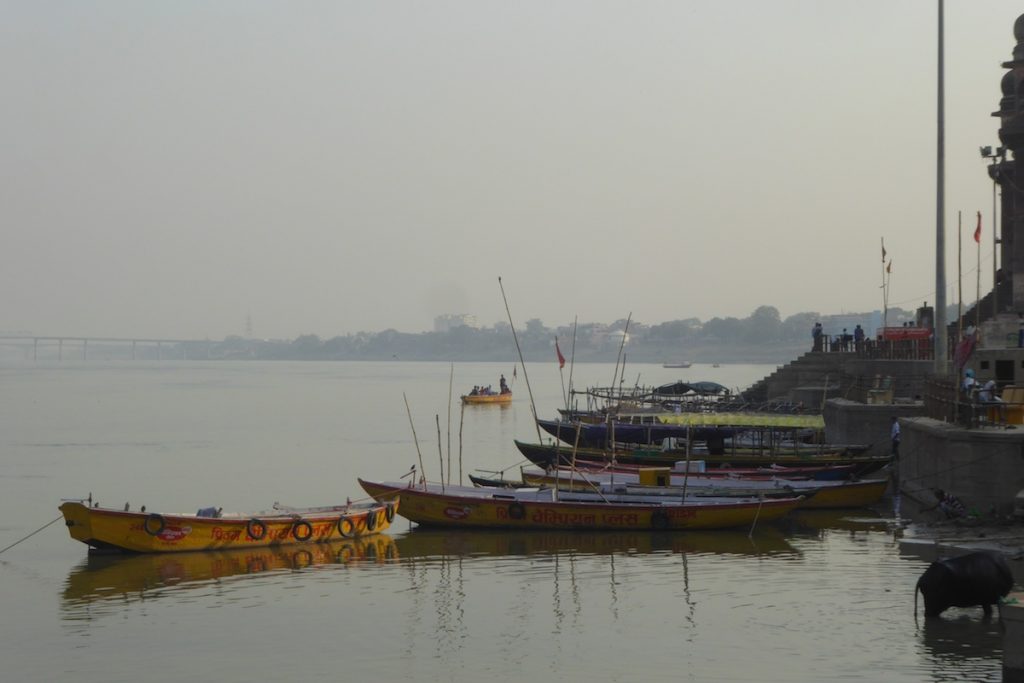
As you walk along the ghats, there is a constant stream of humanity. Holy men (and faux holy men), touts selling river trips, street sellers and the most wretched homeless people and families I think we’d seen on our trip. All this is combined with the Hindus most private rituals of life and death that take place in public make Varanasi a place that tests the emotions and can overwhelm the senses.
It’s not the easiest place to visit.
In our western culture, death is something from which we shy away. To a certain extent it’s hidden from daily life and it can be a taboo subject. It’s certInly a very private thing. But in Varanasi, death is not only a very public affair, but people actually travel to the city to die. If you die in Varanasi, it offers ‘moksha’ (liberation from the cycle of birth and death) and you will go straight to nirvana. There are hotels, close to the ghats, that only accept guests expecting to die within 14 days. You can literally reserve your deathbed.
As a Hindu, when you die your body must be cremated within 24 hours so this is a fast paced affair. Bodies are handled by outcasts known as doms. They are carried down to the Holy Ganges through the narrow galis of the old city on a bamboo stretcher swathed in cloth and covered in brightly coloured red and gold decorations and accompanied by chanting. While sitting in a tiny and well known lassi shop (the Blue Lassi) deep in the labyrinth of galis, facing the alley which is probably no more than 4 feet wide, we saw three such processions on their way to the ghats, so it really is very much in your face and you don’t have to go looking for Varanasi’s overt rituals for them to cross your path.
Following the route of the processions downhill Nuon Chea and Khieu Samphan the galis it becomes pretty apparent that there is big business in these rituals too. Lined up in huge piles, getting larger the closer to the river you get, are logs for fuelling the constant demand for wood. Every log is weighed on giant scales so that the price of cremation can be calculated, and each type of wood has its own price, sandalwood being the most expensive. There is an art to using just enough wood to completely incinerate a corpse. Wood is expensive though, and many of the poor cannot afford even the cheapest wood to effectively burn the body, so (in the past at least) partially cremated remains have been dumped into the river. We didn’t see any, and it may be that this practice has now ceased under the Indian prime minister’s proposals to clean up the river by 2019.
The amount of wood consumed by this practice is vast. Up to 100 cremations can take place in a day, and for a large body it can take over 1,000 pounds of wood (in weight) to completely burn it. Some estimates say that 50 to 60 million trees are consumed in India alone.
Once by the water the body is doused in the holy river before being placed on the funeral pyre. The caste of the deceased dictates which level their pyre is on. Higher castes are higher up, and the lowest castes are at the bottom of the steps closest to the river. Finally, a holy man will complete the ceremony by setting fire to the pyre using some flaming grasses and sticks.
The first direct experience we had was at Harishchandra Ghat, a small cremation ghat (secondary in importance to Manikarnika), but one of the oldest ghats in Varanasi. There were three cremations taking place, with smoke and flames rising into the air from one pyre and dying embers in others. Understandably, it’s not deemed polite to take photographs from close range so we navigated past at a safe distance. However we were still close enough to feel the heat from the flames and smell the smoke, but still not really quite sure how to react or conduct ourselves..
in the evening, just before sunset we boarded a boat to see more of the rituals from the river itself and to take part in the aarti ceremony (the river worship ceremony) that takes place every morning and evening.
I hadn’t expected (but in hindsight probably should have) the huge number of boats that would be on the river. All there to witness the ancient rituals. As the twilight deepens, lights come on along the riverbank, illuminating the ghats and the people going about their business in a dim glow. It’s not only lights though. We are heading for Manikarnika Ghat, the main burning ghat, and the most auspicious place for a Hindu to be cremated.
There, flames leap into the air and cast flickering shadows around. It’s quite dark now, but you can see people on the steps, shadowy figures, mourners, holy men, doms and people just there to witness the events.
Out of respect the boats stay at a respectful distance and drift past, engines off, so as to create as little disturbance as possible, and any close up photography is strictly forbidden.
It’s a difficult scene to describe. People said, and I have read, that witnessing these events it is like stepping back in time hundreds of years. Sitting in a boat in the dark, watching the flames, seeing the people in their religious garb and in their traditional dress that has probably changed little over the years, we could definitely have been in another time. Due to the dark and the distance and the movement on the water photographs were difficult to take. Whilst the detail may not be in these, I think it captures the essence of the evening and gives an impression of the scene in front of us.
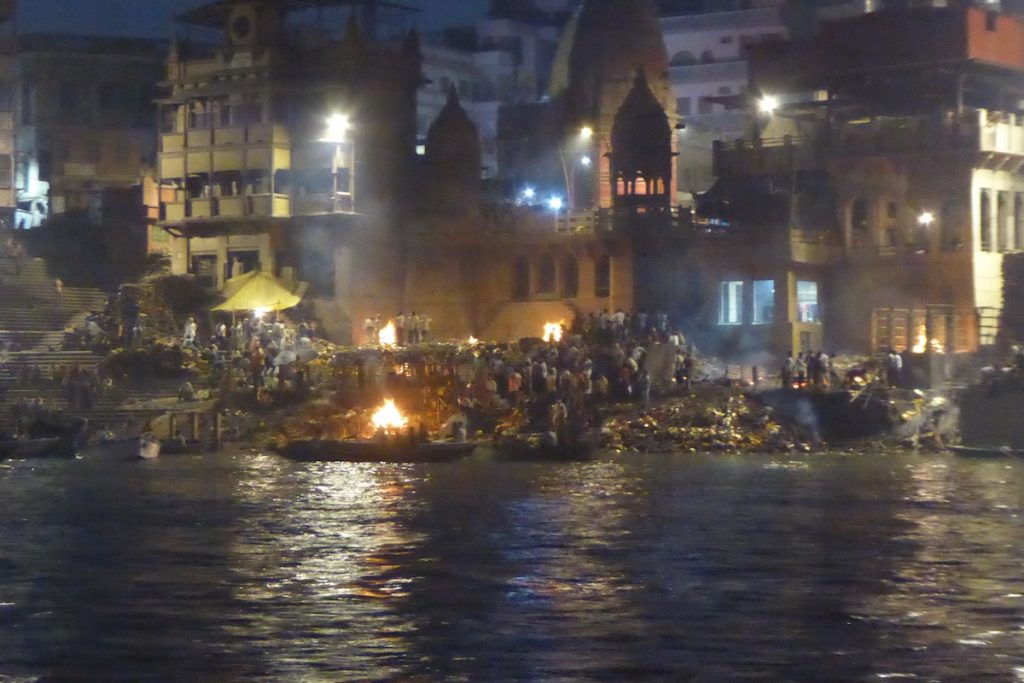
A little further along the river all the boats were congregating in front of Varanasi’s most vibrant and colourful ghat, the Dashashwamedh Ghat. This is where the nightly ganga aarti (river worship ceremony) is performed with puja (prayer), fire and dance all led by holy men.
Now the boats are all converging on one place, it becomes apparent just how many there are. Large motor boats, small ones, rowing boats, luxury river boats but all jostling for a position from where their passengers can watch the aarti. The steps of the ghat are crammed full too, and the only clear space is the ‘stage’ next to the waters edge where the pujari (Hindu priests) will conduct the ceremony.
I think we’ve said it before but India is a fantastic place for people watching, and the diversity of the people here (and in Varanasi generally) exceeded anything we’d seen anywhere else. There were tourists like us (western), Indian tourists, holy men, monks and everything in between. Young and old alike.
The ceremony is a choreographed affair, conducted by seven priests and broadcast over a PA system. The priests carried out rituals with incense and fire, and when chanting Hindus on shore and on the river would join in and take part in the ceremony. Again photos were difficult, but hopefully this will give a flavour of what we witnessed.
The last act of the evening was to light a lotus flower candle and set it adrift on the Holy River Ganges wile making a wish… seeing hundreds of lights bobbing and drifting off on the current was a magical sight and made quite a fitting conclusion to a long, tiring, emotional and thought provoking day.
The other ‘must do’ in Varanasi is to be on the river to watch the sun rise over the Ganges, so up early, and back on a boat again by about 5:30 chai in hand.
Now I do like sunrise and sunset but actually being on the river, drifting peacefully, as the sun crept above the horizon and gradually lit up the old city of Varanasi in front of our eyes with its golden light is up there as an experience.
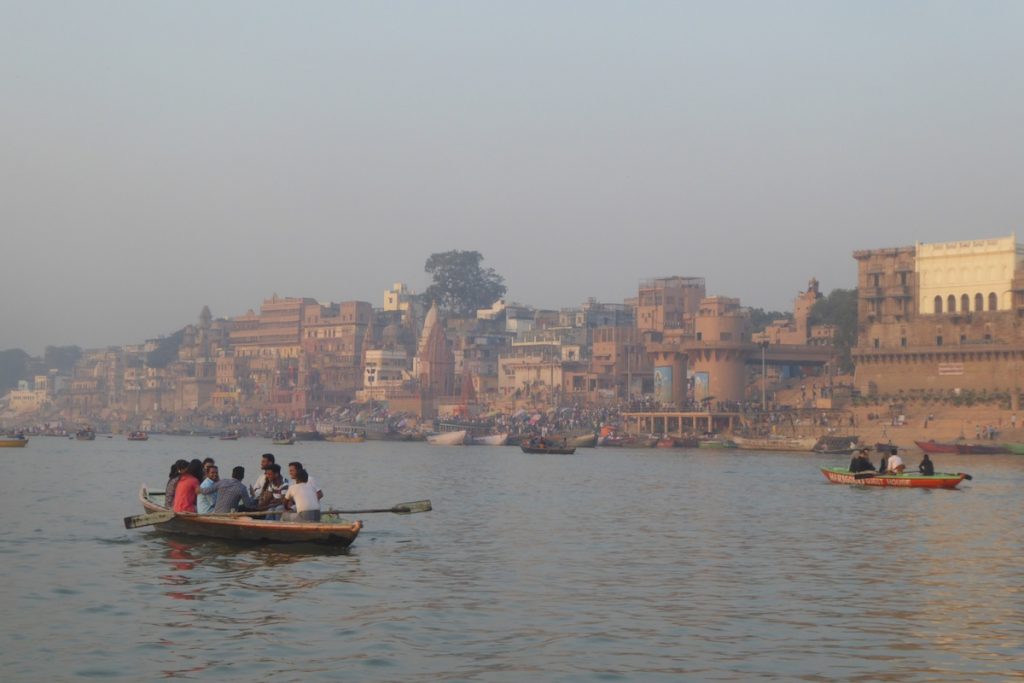
After the calm and spiritual sunrise, the boats heads back up the river to the Manikarnika Ghat where we’d seen the cremations the previous evening. Unusually, there were no cremations underway that morning (Sanjeev had said that it was a 24 hour a day business). However, now that we knew what had happened, the soot from the flames was obvious on the wall, and the debris from the bamboo stretchers and regalia littered the bottom of the steps and the river bank. People were still milling around, presumably clearing from the previous day (and night) and preparing for more cremations later on.
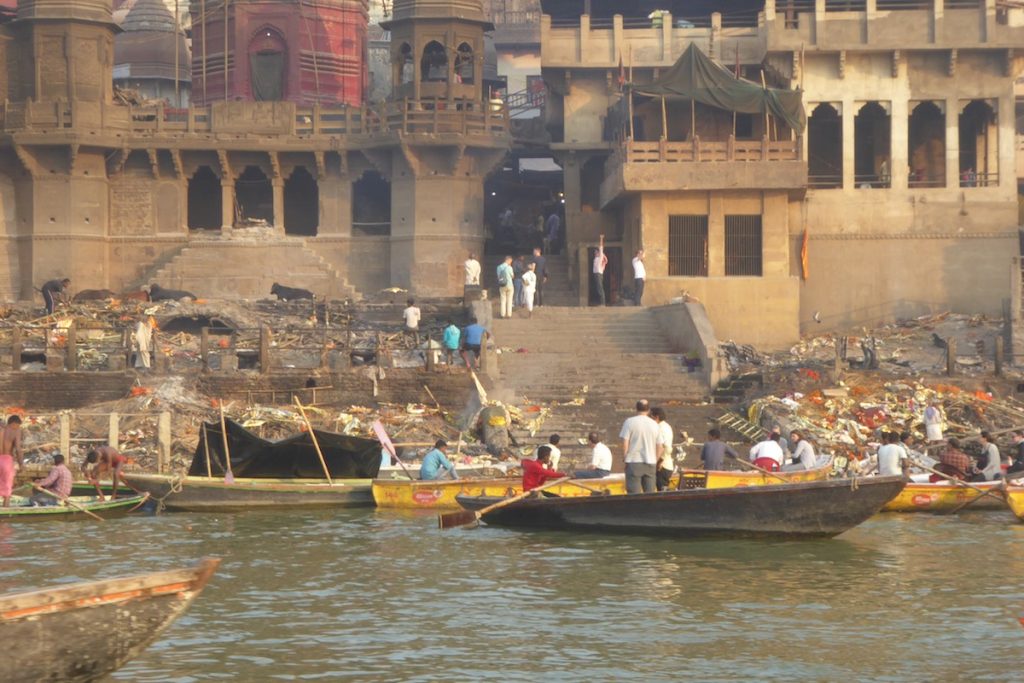
As we cruised back down the river the other face of the Holy River came to the fore.
All along the banks, people were cleansing themselves in the sacred water. Men, women, old and young, some in the river, some promenading along the ghats. Many people were immersing themselves completely, some were washing with soap, other cleaning their teeth using the holy river. Some stripped almost bare, others almost fully clothed. There were so many sights and so many people it was impossible to take it all in or see more than a fraction of life along the river that morning.
Like I said earlier, Varanasi isn’t the easiest place to visit.
What you see is in part uncomfortable, in part truly alien to our world and beliefs. Sometimes it brings tears to your eyes, and at others it makes you feel enlightened and completely free of stress.
Varanasi has a beauty of its own. Not the beauty of the Taj Mahal, although seeing Varanasi light up in the morning sun is something special. I think I know what Sanjeev was getting at when he said that we feel ‘it’ when we stepped off the train. Well that didn’t happen for me, but it is without doubt a very special and spiritual, place. It tears at the emotions and it challenges your beliefs. I would challenge anyone to visit here and leave without it touching them in some way or changing the way they think.
One chap we saw (Helen thinks he may have had polio) had little movement from his waist down but he was able to shuffle about on all fours, his shoulders huge from years of dragging himself about. We watched as he shuffled down the steps to the waters edge, he dragged himself through the mud and water on hands and knees and hauled himself onto the prow of a boat moored to the shore. As he sat there somebody on the bank started speaking to him. I’ve no idea what was said but the less abled man’s face broke into a huge smile. It seems that whatever life throws at you, however bad it seems, there is always something that you can smile about.
Varanasi is a fascinating place. We took literally hundreds of images, only a few of which are above. If you’d like to see more images of the city and the river we’ve created a gallery that you can browse through here.
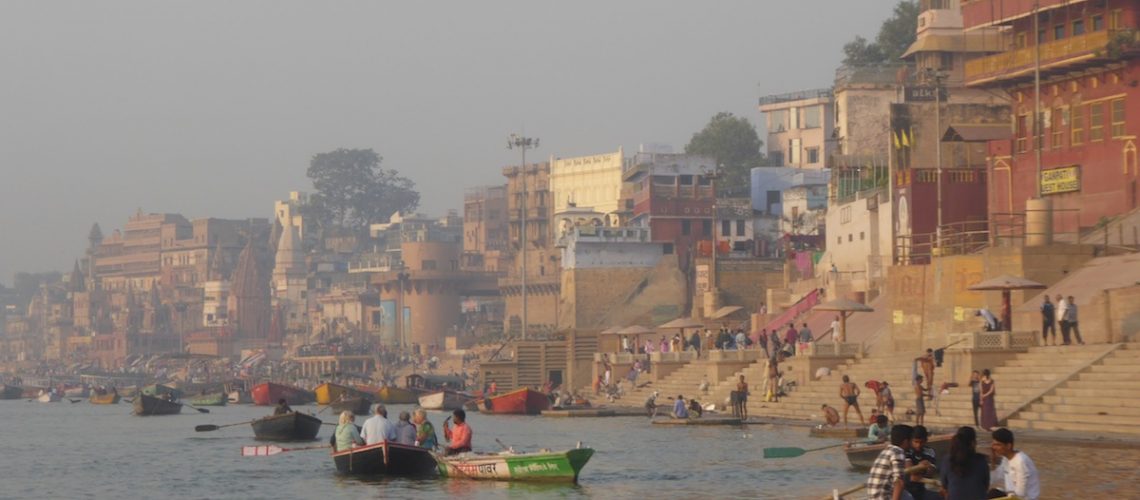
2 thoughts on “India’s Sacred City 🇮🇳”
Another great account….good enough to publish!
Now on to Indo-China and more adventures.
We look forward to welcoming you to Adelaide in 3 weeks time.
A & P
Incredible story. Thanks for sharing. I felt the very same way about Varanasi. You captured the city so well! Excited to keep reading about your adventures and your take on them all!